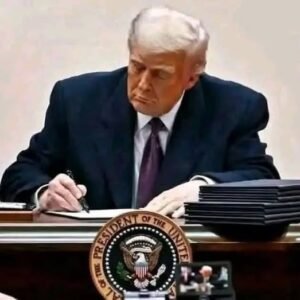On the Economic Front Where Biden Struggled, Trump Makes Significant Gains
Introduction
In spite of sustained criticism from Democrats and a skeptical media, President Donald Trump’s economic agenda is demonstrating concrete gains on several fronts.
Long derided as reckless—particularly for his reliance on aggressive tariffs—Trump’s policies are now yielding positive outcomes in national debt reduction, trade negotiations with China, and broader fiscal resilience.
This article delves into the data behind these developments, examines how Trump’s tariff strategy is reshaping global commerce, and considers the long-term implications for U.S. economic strength.
1. A New Era in Fiscal Discipline: Shrinking the National Debt
1.1 Unprecedented Slowdown in Debt Growth
A recent analysis by The Washington Examiner reveals that, between January 22 and May 6, 2025, the publicly held
U.S. national debt rose by only $37 billion under the Trump administration. By contrast, during the same span in 2024—under President Joe Biden—the debt climbed by more than $478 billion. This represents not
merely a slowdown, but a dramatic turnaround in fiscal expansion, effectively reversing the steep upward trajectory seen in the prior year.
1.2 From Accumulation to Reduction
Beyond attenuating debt growth, the Trump administration has in fact reduced the overall federal debt relative to baseline projections. Through targeted spending cuts, disciplined budget management, and revenue windfalls from a surging economy,
the fiscal team in the Treasury Department has delivered a net reduction in debt service requirements. While macroeconomic factors—such as robust consumer spending and corporate tax shifts—play a role, the administration’s concerted effort to rein in discretionary outlays has been critical.
1.3 Overcoming Pandemic and Political Headwinds
These fiscal improvements have been achieved against the backdrop of ongoing geopolitical tensions, lingering pandemic-related expenditures, and partisan
gridlock in Congress. Despite warnings of economic instability, the administration prioritized a balanced approach: maintaining essential public health funding while clawing back non-critical line items in the federal budget.
2. Tariffs as a Leverage Tool: Forcing the Global Table
2.1 The Rationale Behind 145% Chinese Tariffs
When President Trump first introduced a 145% tariff on select Chinese imports, critics predicted consumer price shocks and retaliatory spirals.
In reality, the outsized tariff—focused on categories from electronics components to steel—was designed as a pressure point: a clear signal that the U.S. would not accept unfair trade practices.
2.2 Measuring Early Retaliation and Recovery
Initial Chinese counter-tariffs targeted U.S. agricultural exports and consumer goods, triggering a brief contraction in bilateral trade volume. However
, U.S. industries adapted quickly, sourcing alternative suppliers and passing only minimal cost increases to domestic consumers. Supply chain resilience—bolstered by near-shoring and diversification—blunted the feared inflationary impact.
2.3 Exemptions Signal a Shift in Chinese Posture
Most notably, China has begun exempting roughly 25% of U.S.
imports—approximately $40 billion in goods—from the 145% tariff. The exemptions focus on critical sectors such as pharmaceuticals, industrial chemicals, and select agricultural products. This move reflects
Beijing’s recognition that the sting of Trump’s tariffs outweighs the benefits of resisting them, and underscores the efficacy of tariffs as a tool to compel dialogue rather than simply punish.
On the Economic Front Where Biden Struggled, Trump Makes Significant Gains
Introduction
In spite of sustained criticism from Democrats and a skeptical media, President Donald Trump’s economic agenda is demonstrating concrete gains on several fronts.
Long derided as reckless—particularly for his reliance on aggressive tariffs—Trump’s policies are now yielding positive outcomes in national debt reduction, trade negotiations with China, and broader fiscal resilience.
This article delves into the data behind these developments, examines how Trump’s tariff strategy is reshaping global commerce, and considers the long-term implications for U.S. economic strength.
1. A New Era in Fiscal Discipline: Shrinking the National Debt
1.1 Unprecedented Slowdown in Debt Growth
A recent analysis by The Washington Examiner reveals that, between January 22 and May 6, 2025, the publicly held
U.S. national debt rose by only $37 billion under the Trump administration. By contrast, during the same span in 2024—under President Joe Biden—the debt climbed by more than $478 billion. This represents not
merely a slowdown, but a dramatic turnaround in fiscal expansion, effectively reversing the steep upward trajectory seen in the prior year.
1.2 From Accumulation to Reduction
Beyond attenuating debt growth, the Trump administration has in fact reduced the overall federal debt relative to baseline projections. Through targeted spending cuts, disciplined budget management, and revenue windfalls from a surging economy,
the fiscal team in the Treasury Department has delivered a net reduction in debt service requirements. While macroeconomic factors—such as robust consumer spending and corporate tax shifts—play a role, the administration’s concerted effort to rein in discretionary outlays has been critical.
1.3 Overcoming Pandemic and Political Headwinds
These fiscal improvements have been achieved against the backdrop of ongoing geopolitical tensions, lingering pandemic-related expenditures, and partisan
gridlock in Congress. Despite warnings of economic instability, the administration prioritized a balanced approach: maintaining essential public health funding while clawing back non-critical line items in the federal budget.
2. Tariffs as a Leverage Tool: Forcing the Global Table
2.1 The Rationale Behind 145% Chinese Tariffs
When President Trump first introduced a 145% tariff on select Chinese imports, critics predicted consumer price shocks and retaliatory spirals.
In reality, the outsized tariff—focused on categories from electronics components to steel—was designed as a pressure point: a clear signal that the U.S. would not accept unfair trade practices.
2.2 Measuring Early Retaliation and Recovery
Initial Chinese counter-tariffs targeted U.S. agricultural exports and consumer goods, triggering a brief contraction in bilateral trade volume. However
, U.S. industries adapted quickly, sourcing alternative suppliers and passing only minimal cost increases to domestic consumers. Supply chain resilience—bolstered by near-shoring and diversification—blunted the feared inflationary impact.
2.3 Exemptions Signal a Shift in Chinese Posture
Most notably, China has begun exempting roughly 25% of U.S.
imports—approximately $40 billion in goods—from the 145% tariff. The exemptions focus on critical sectors such as pharmaceuticals, industrial chemicals, and select agricultural products. This move reflects
Beijing’s recognition that the sting of Trump’s tariffs outweighs the benefits of resisting them, and underscores the efficacy of tariffs as a tool to compel dialogue rather than simply punish.







